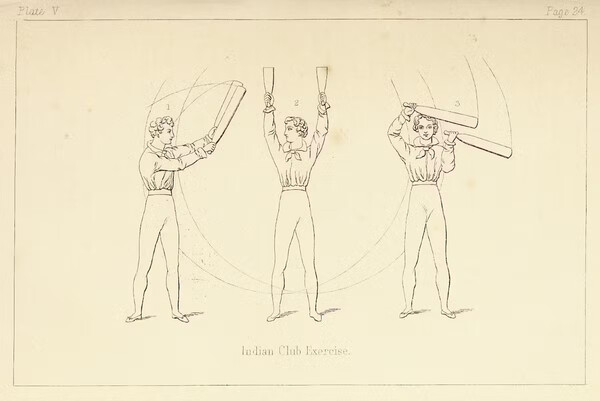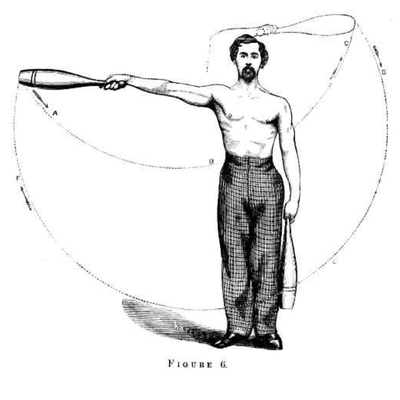
I had been interested in traditional workouts and training programs for a long time, and reading some excerpts from manuals from the 19th century 1 2 3 and watching a YouTube video on Indian Clubs by Physical Culture Historians 4 5, I became interested in trying out Indian Club exercises myself. The alleged benefits—such as improved shoulder health, cardiovascular fitness (when running, cycling, swimming, or jump rope aren’t possible), and strength endurance depending on the weight and exercises—eventually led me to purchase my first set of Indian Clubs: a modest pair weighing just 0.4 kg (1 lb).
Referencing several videos6 7 8 and the aforementioned manuals, I started swinging the clubs, and it was surprisingly fun—though unexpectedly tough for such a light weight. My shoulders, forearms, and even the muscles in my palms felt that first workout. It also showed how asymmetrical my skill level was. While my right arm and hand quickly picked up the movements, especially the smaller wrist rotations, my left side struggled significantly with the latter. What started as a physical exercise for health, strength, and cardiovascular endurance soon became a neuro-muscular challenge as well.

After about six months, I decided to try slightly heavier clubs and eventually settled on a set of 1.4 kg (3 lb) clubs. The difference was dramatic. At first, I could barely swing them for a minute before my hands and forearms gave out. While 1.4 kg may sound unimpressive, the effort required to accelerate, decelerate, stop, and control them was brutal. By the second workout, things felt slightly easier, but I’m still working towards swinging them as smoothly as I do the 0.4 kg clubs.
Reading about people from the past (and today on YouTube) effortlessly swinging 1.4 kg or heavier clubs is jut … really impressive. The grip strength and stability needed for
10+ kg clubs that are almost just as tall as oneself must be immense.
There are much heavier clubs and even maces available, and perhaps I’ll try out a mace someday—but for now, I think I have plenty to work on. Since getting the 1.4 kg clubs, the 0.4 kg ones feel even lighter in comparison, which has allowed me to experiment with more graceful and elegant moves designed to improve body control and the mind-body connection.
I think the low intensity of the light clubs (light clubs being between 0.4 and 1.5 kg) makes this a great tool for daily exercises. I wager that it also helps with regeneration if done within moderation on rest days. It certainly gets the blood moving.
A Bit of History
Originally designed to build strength for wrestling, Indian Clubs were later adopted by the British Army for rehabilitating wounded soldiers (a practice that continues in therapy today) as well as training healthy soldiers. Instead of using the heavy clubs favored by Indian wrestlers, the British focused on lighter ones (starting at around 1 kg for beginners).
Over time, club swinging spread into civilian society, where even lighter clubs were used to turn it into an art form emphasizing grace and coordination rather than just strength and endurance.
Some links
Indian Club Books and Manuals
Eastern Sports and Western Bodies
The “Indian Club” in the United States